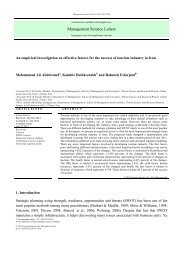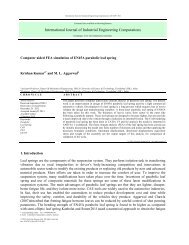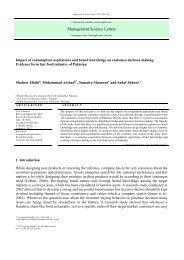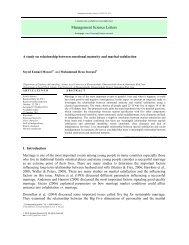PDF (276 K) - Growing Science
PDF (276 K) - Growing Science
PDF (276 K) - Growing Science
Create successful ePaper yourself
Turn your PDF publications into a flip-book with our unique Google optimized e-Paper software.
328<br />
The work-in-process holding costs for all three cases are calculated as follows.<br />
That is for case (a):<br />
1 7<br />
X .( C − j) . γ = [1.(6 − 1) + 0.(6 − 2) + 0.(6 − 3) + 0.(6 − 4) + 1.(6 − 5) + 1.(6 −6)].<br />
γ = 6γ<br />
∑∑<br />
i= 1 j=<br />
1<br />
ij i i<br />
That is for case (b):<br />
= [1.(6 − 1) + 1.(6 − 2) + 0.(6 − 3) + 0.(6 − 4) + 0.(6 − 5) + 1.(6 − 6)]. γ1 = 9γ<br />
1<br />
That is for case (c):<br />
= [0.(6 − 1) + 0.(6 − 2) + 0.(6 − 3) + 1.(6 − 4) + 1.(6 − 5) + 1.(6 − 6)]. γ = 3γ<br />
1 1<br />
1 1<br />
The flow time for cases (a) and (b) is 6 and for case (c) is 3. Therefore, in case (c) a less holding cost<br />
is incurred in compare to cases (a) and (b) which is equal to3γ 1.<br />
The second time unit of process for<br />
case (a) is done in position 5 and for case (b) is done in position 2. Then, the amount of work-inprocess<br />
in case (b) is more than it in case (a) and consequently it incurs more holding cost in compare<br />
to case (a) based on assumption 13.<br />
4. Linearization of the proposed model<br />
In this section, we present the linearization procedure and the liberalized model.<br />
4.1. Linearization procedure<br />
The linearization procedure that we propose here consists of four steps that are given by the four<br />
propositions stated below. Terms (1.2), (1.3), (8) and (9) are non-linear, therefore, these four terms<br />
will be liberalized using the following auxiliary variables XPij, XMij, Mij, Qij, Rij, Fij and Bij. Each<br />
proposition for linearization is followed by a proof that illustrates the meaning of each auxiliary<br />
(linearization) variable and additional constraints.<br />
Proposition1. The non-linear term of the objective function (1.2) can be liberalized by the following<br />
X − X = XP + XM , under the following set of constraints:<br />
transformation ij ij + 1 ij ij<br />
X − X = XP − XM ∀ i, j;<br />
(10)<br />
ij ij+ 1 ij ij<br />
The proof of this proposition is given in Appendix A.<br />
Proposition2. The non-linear work-in-process holding cost terms in the objective function (1.3) can<br />
be liberalized with X .( C − j) = M , under the following set of constraints:<br />
ij i ij<br />
M ≥( C − j) − A(1 − X ) ∀ i, j;<br />
(11)<br />
ij i ij<br />
The proof of this proposition is given in Appendix B.<br />
Proposition3. The non-linear constraint (8) can be liberalized by the following transformation<br />
max( X . j) = Q , under the following sets of constraints:<br />
j<br />
ij iJ<br />
Qi1 = Xi1 ∀ i;<br />
(12.1)<br />
Q = Q .(1 − X ) + ( j. X ) ∀ i, j;<br />
(12.2)<br />
ij ij−1 ij ij<br />
The proof of this proposition is given in Appendix C.<br />
Proposition4. The non-linear constraint (9) can be liberalized by adding the following set of<br />
constraints:








